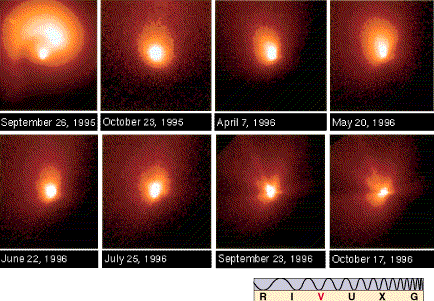| One of the most spectacular comets in recent years was comet Hyakutake 1996. Named after a Japanese amateur astronomer who noticed it as "something odd and out of place" while scanning the skies with a pair of binoculars, Hyakutake grew from a small smudge while still far from the Sun into a splendid display comprising a huge coma nearly the apparent size of the Moon and a tail that eventually stretched a third of the way across the sky. The accompanying figure shows a Hubble Space Telescope image of Hyakutake taken in March 1996, when the comet passed closest to Earth—only 15 million km (0.1 A.U.) away. The comet's icy nucleus, the brightest point in the image, is unresolved here (the field of view is about 1000 km across), but radar pulses sent toward Hyakutake did return an echo, indicating that the diameter of the nucleus was 1 to 3 km. In the image, the Sun is out of the frame at bottom right, and the innermost part of the comet's tail is at upper left (on the side opposite the Sun, as explained in the text).
Other images showed sporadic jets pointing mostly sunward. These jets were gases gushing from the side of the comet closest to the Sun before wrapping around to become part of the graceful tail. The comet was examined at every conceivable wavelength, but perhaps the most surprising result was the intense X-rays emitted from its head. Even the sunward side of the comet was far too cool to emit X-rays, which are usually associated with very-high-temperature phenomena. Astronomers speculate that the X-rays were produced by shock waves created as the solar wind hit the leading edge of the comet's coma. Hot on the heels of Hyakutake came another interplanetary vagabond—comet Hale-Bopp 1995. Discovered in 1995 by two American amateur astronomers, it reached its maximum brightness in the spring of 1997. Outshining everything in the night sky except the Moon and the brightest planets and stars, Hale-Bopp was probably the most widely viewed and studied comet in history. This comet's unusual brightness and long (20°) tail was probably caused by a huge nucleus—about 30—40 km in diameter. That's a very large ball of dirty ice, compared with the average comet core, which measures some 3—5 km across. The comet or asteroid that struck the Earth 65 million years ago (see Interlude 14.1), perhaps causing the extinction |
of the dinosaurs, is thought to have been about 10—15 km in size. At perihelion, Hale-Bopp's hydrogen envelope was enormous—1 A.U. across.
The accompanying figure shows a series of HST observations of the inner part of comet Hale-Bopp. The colors are artificial, with white representing the brightest parts of the comet, and red less bright; resolution is nearly 500 km, far larger than the estimated size of the icy nucleus itself. These eight pictures were taken over the course of a year, from September 1995 to October 1996 as the comet neared the Sun. Astronomers used multiple images like these to chronicle the evolution of the comet's nucleus. Especially interesting is the dust outburst in the first photo at top left—even when Hale-Bopp was still far beyond the orbit of Jupiter. At bottom right, as the comet neared the Sun, multiple jets are seen emanating from the surface. The dramatic increase in activity as the comet approached the Sun is clearly evident in this time sequence. Hubble was unable to follow the comet even closer to the Sun (which it rounded on April 1997, at a perihelion distance of 0.9 A.U.), for fear of damaging its delicate optics. Apart from its unusual size, Hale-Bopp seems to be quite representative of many long-period comets. Just about all the molecules previously known from other comets were seen in Hale-Bopp's spectrum. New infrared observing techniques allowed, for the first time, identification of many of the minerals making up the comet's dust, which was found to be very similar to the interplanetary dust found in near-Earth space and collected in Earth's upper atmosphere. What was unique about Hale-Bopp was that, being so large, it could be observed for a very long period of time, even when far from the Sun, allowing observers to keep a continuous and detailed record of its evolution. Hale-Bopp is now moving out of the inner solar system, its incoming orbit modified by the forces from its jets. Astronomers plan to monitor the comet for several more years as it moves far from the Sun's warmth, and its activity winds down. After a trip well outside the orbit of Pluto, extending some 350 A.U. from the Sun, the comet will return to the inner solar system in about 2400 years. |
|
|
|
